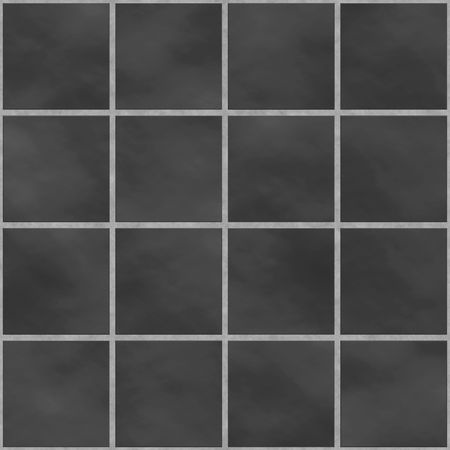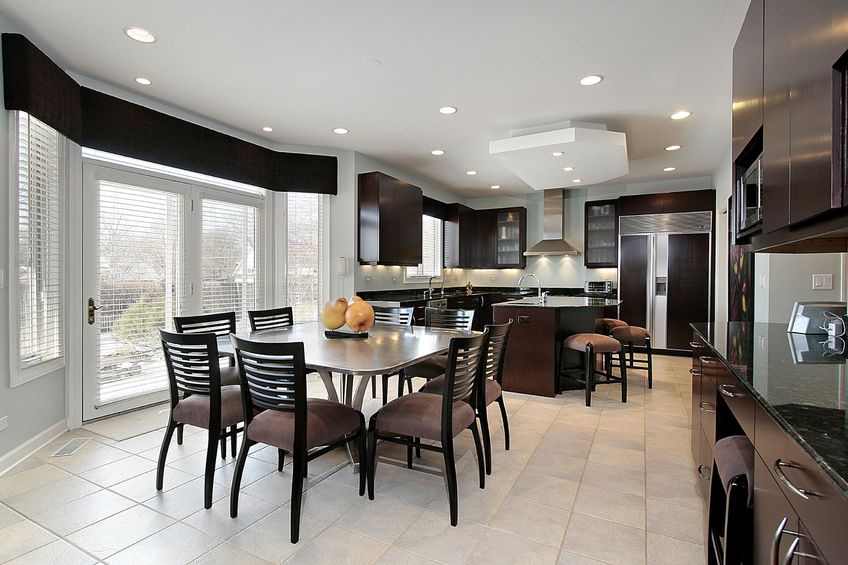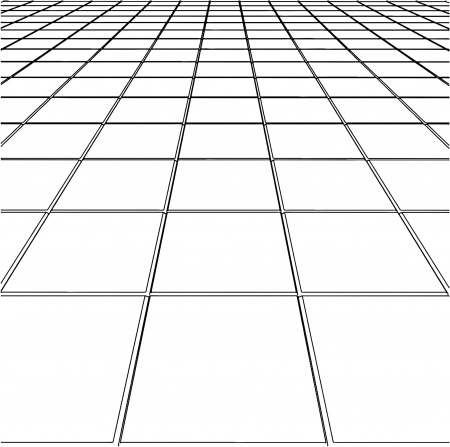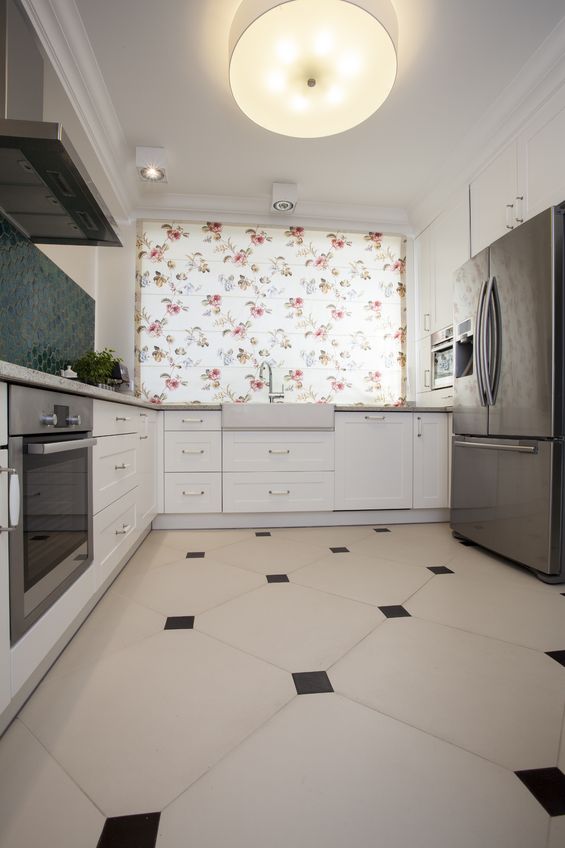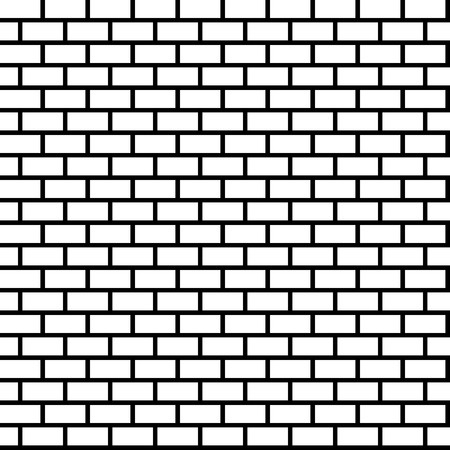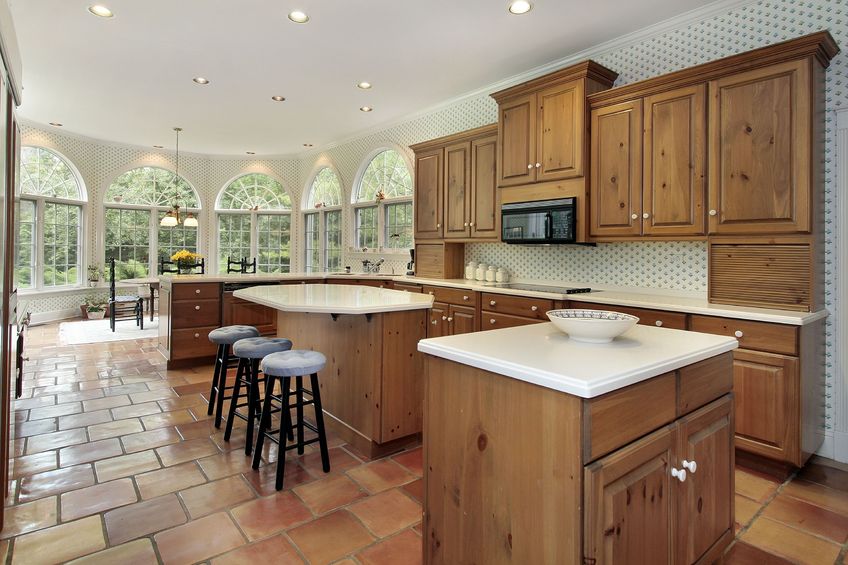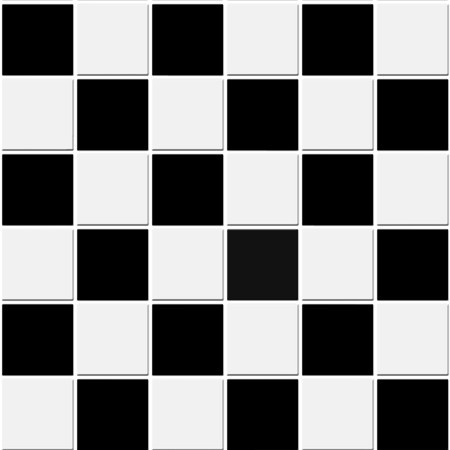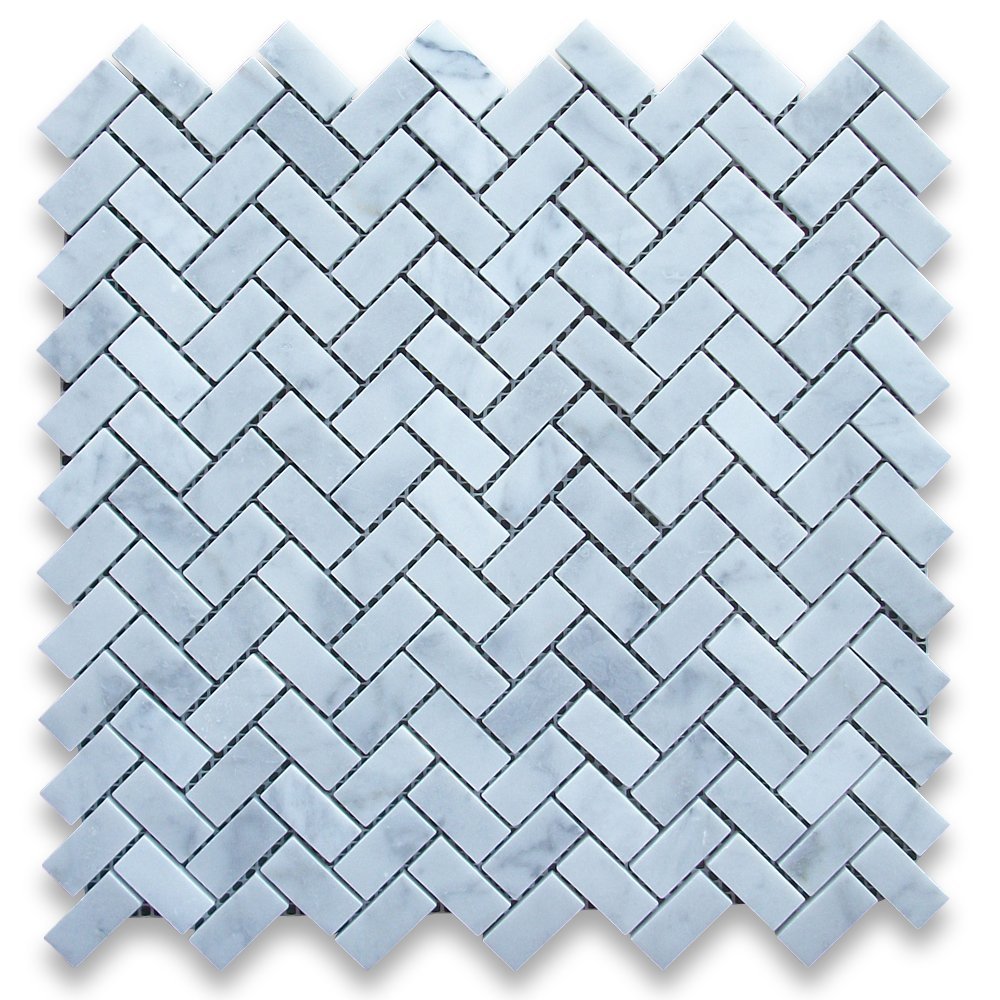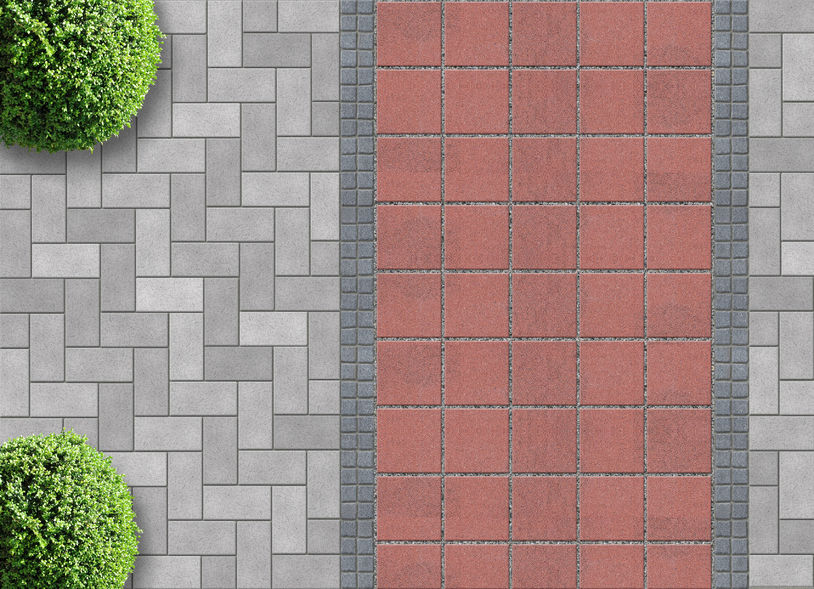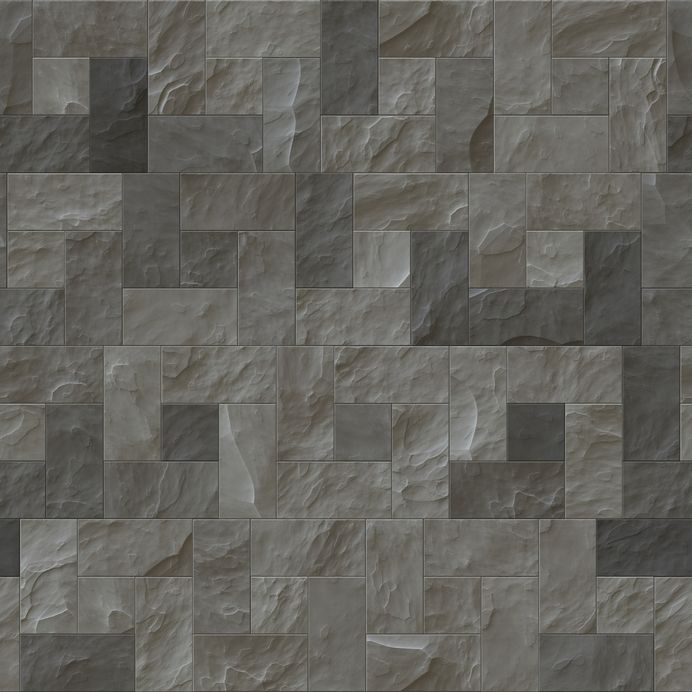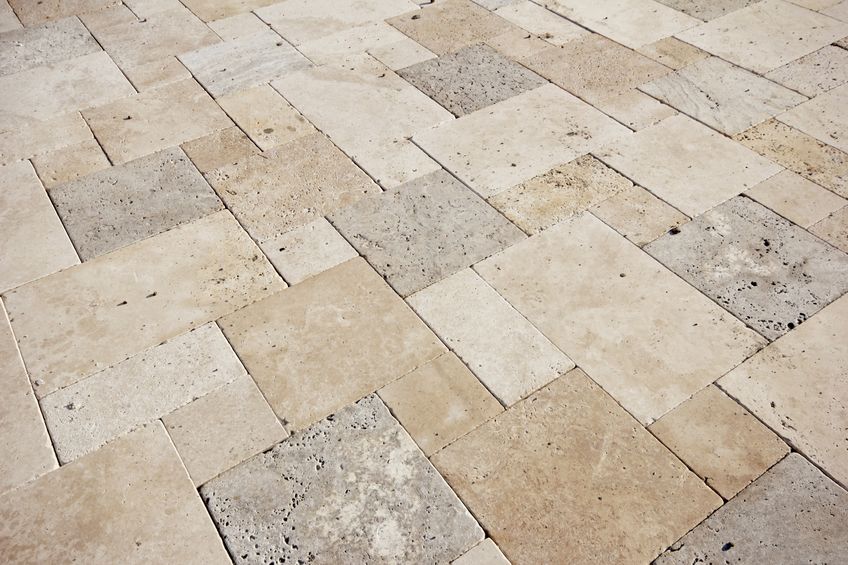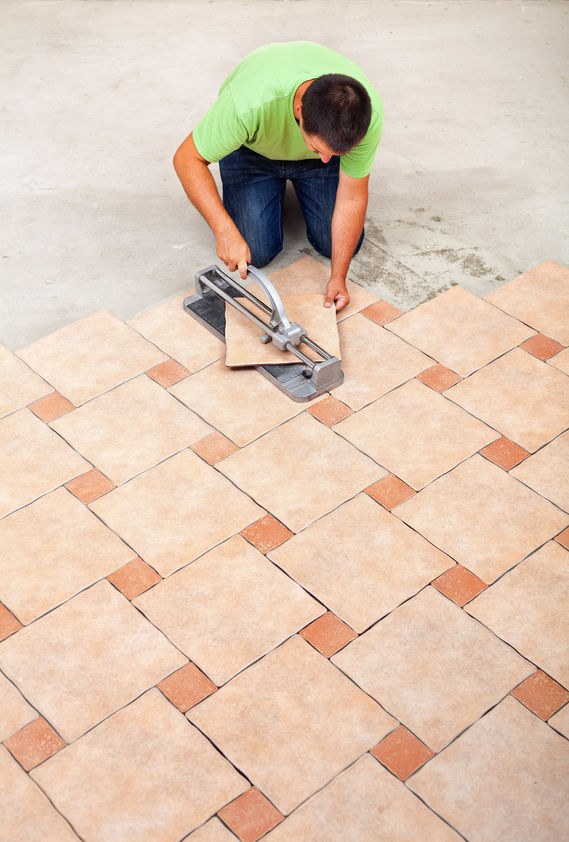Tile patterns can enhance the look, feel, and atmosphere of any room, but that is only if they are used correctly. To be able to choose the right pattern for your space you need to know the secrets of the professionals and how to apply them. And with tile pattern names like Versailles and herringbone which might not be so self-explanatory to someone who is not a pro., you’ll also need to know what each one is as well. So here are the the most useful and popular patterns which everyone considering using tiles in their home needs to know, with of course the secrets to using them to their full potential.
The Straight Lay Tile Pattern
The Basics: This is the most basic and easy to install of all the patterns. For that and a few more reasons that you will soon read about, it is one of the most commonly used wall and floor tile patterns around the world. It works anywhere and everywhere. The tiles are first laid side by side in a straight line. The are corners matched up, and then grout is applied in straight, perpendicular intersecting lines. With its grid-like pattern, the straight lay is typically used for a simple, clean, yet modern look.
Tile Home Guide Secret Tips
-Just because it is the most simple don’t skip over this one. It’s a great choice for DIY enthusiasts and anyone who wants to learn to tile. Best of all it simplicity can really add to it’s appeal which means its can work with every style of decor. It’s an easy “go to,” choice that is guaranteed to please, especially with so many materials, sizes, colors, and styles of tile available to choose from.
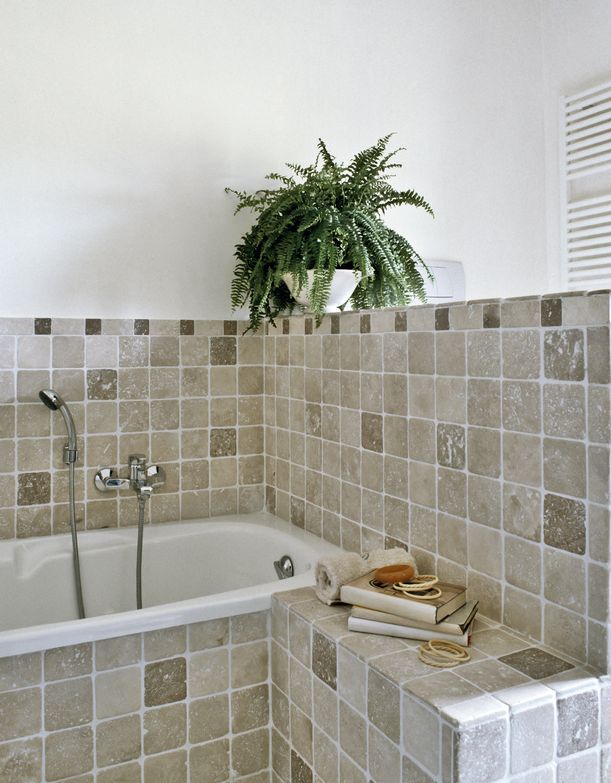
The straight lay is the most common of all wall tile patterns for bathrooms
-A great function of the straight lay tile pattern, especially with solid colored tiles, is that it can also be used in an area or room that has more complicated patterns, designs, or colors, without competing or clashing with them. This makes it a perfect, practical, solution for a busy room that needs the benefits of a tile floor, but none of the distractions of a complex pattern.
-This is one of the only tile layout patterns which uses very long, straight, grout lines. Why is that a good thing? It’s because the human eye naturally follows these straight lines when looking at this pattern. You can use this to your advantage by using the lines to lead the eye of the viewer through the room. That could mean into another space or to an important aspect or highlight of the room, such as a stunning view, prominent feature or focal point. You wouldn’t think such a simple tile pattern could be used this way.
-You don’t need something complicated to create style. Simple can go a really long way. Most people are often surprised at just how modern and stylish the straight lay can be with the right tile material.
The Diagonal Tile Pattern
The Basics: Simple and easy to install, this is a great tool to have in your tile pattern arsenal. Similar to the straight lay, however in this pattern the tiles are laid at a 45 degree angle. instead of straight. This changes the square tiles into diamonds. It is probably the second most common after the straight lay, and is ideal wall and floor use alike.
Tile Home Guide Secret Tips:
-The diagonal tile pattern can be a smart choice if you are looking to try something a little different than the straight lay. It could also be an excellent way to improve on and reinforce your basic tile laying skills if you are doing the project yourself.
– This pattern is actually one secret decorators and tile professionals, use for making a room look bigger and wider than it really is. The key to this pattern is that the focus is taken off of the narrowness of the room, and shifted onto the wide angles of the tile borders. Because the tiles’ angles are in line with the viewer, they see the tile grout lines spreading out across the room. This makes them feel like they are in a much larger space they really are. It’s a great choice for floor pattern choice for a small bathroom or really any room that you would like to look bigger.
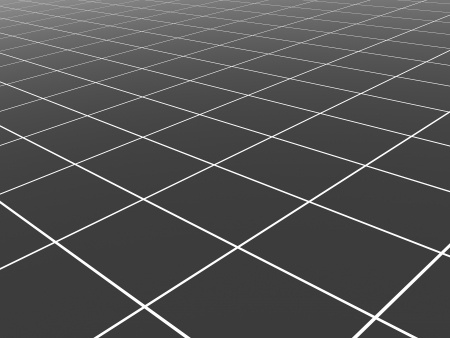
You can really see here how much more expansive a room can look when using the diagonal tile pattern
-On A kitchen backsplash is another very attractive way to use this pattern. Diamond shapes can look very appealing on the way and make an interesting contrast or accent to other patterns in the room.
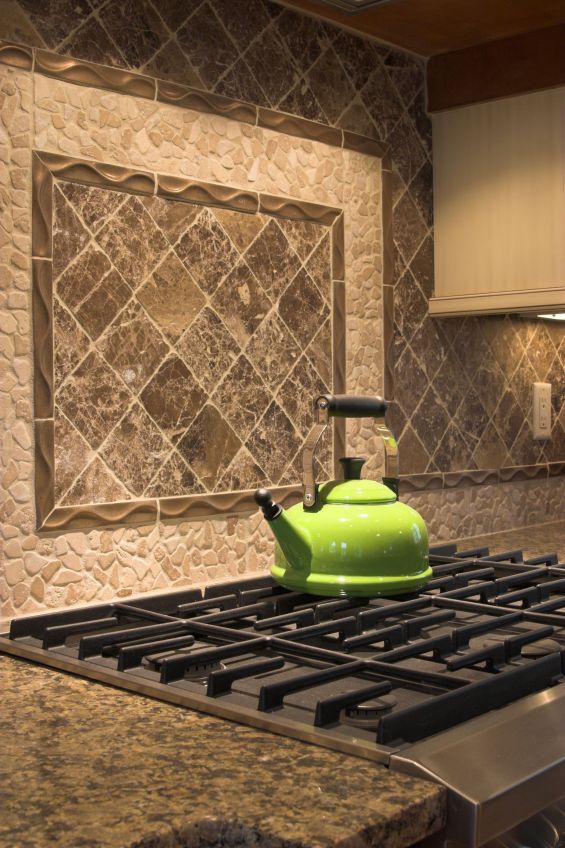
Accenting the existing pattern in the room and framed by pebble tile this stone tile bacskplash shows just how much the diagonal tile pattern has to offer!
-Tile borders too, can be a fantastic looking yet easy way to put the diagonal to work when used adjacent to other tile laying patterns. It can really add that “extra something,” that you may be in need of. That is why you will see it used this way on many bathroom walls and in showers that are using the straight lay as their primary wall tile pattern as it can help spice things up a little bit.
-Another variation of this pattern is to use large tiles and add accent tiles at regular intervals. This can be very classy looking and is known as the diagonal with dots.
The Running Bond Tile Pattern
The Basics: Also called the brick pattern, because it is the most commonly used pattern in brickwork, it is also known as the running bond. You will sometimes but not as often, hear it named the brickwork pattern as well. Whatever name you choose to call it, this is another simple, yet good looking option. Typically used with rectangular tiles and subway tiles, the end of each tile is lined up with the center of the tiles which are both directly above and below it. This creates a staggered pattern, yet a cohesive look. It is another one of the easier tile pattern installations, however in doing so you should make sure that the tiles line up as well as possible because you don’t want this mistake to become apparent as you continue tiling further down the line. And while tile removal is not difficult task, it’s always easier to get it right on the first try.
Tile Home Guide Secret Tips:
– So what’s the secret of using the running bond? It’s that it’s used to keep secrets! The running bond is one of the best tile layout patterns for hiding imperfections. Uneven surfaces, crooked walls, small differences in tile size and various other imperfections, are all easily covered up using this pattern. The fact that the tiles don’t line up in a straight line, tricks the eye by taking the focus off of individual tiles, and onto the pattern as a whole cohesive image instead. This makes it almost impossible to spot flaws. Who would have thought?
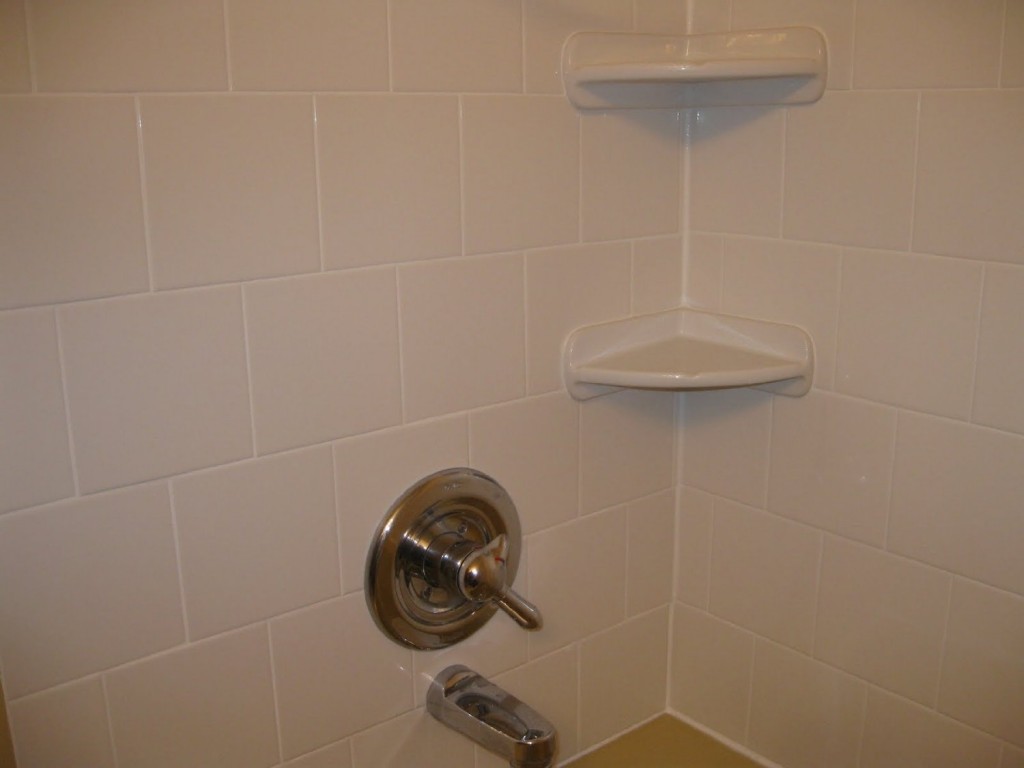
Don’t overlook square tiles if you like the running bond, these are actually square 6″ x 6″ ceramic tiles!
-Don’t make the mistake of thinking it is only a wall pattern because you see there so often on backsplashes and in bathrooms. The running bond tile pattern extremely versatile and can also be used outdoors on patios and walkways, not only because of its simple design, but because of its weight bearing ability and strength. In the home they also make for a one of the least difficult and good looking floor tile patterns you can choose.
The Checkerboard Tile Pattern
The Basics: This two color alternating pattern uses square tiles and looks just like a checker or chessboard, creating a truly classic look. Usually this pattern uses white and black floor tiles. However, the black is sometimes substituted for another color such as tan or gray. It is considered easy to install because it uses either the straight lay or diagonal pattern. Typically used as a floor pattern in living rooms, mud rooms, entry ways and kitchens, it is also one of the more commonly used bathroom tile patterns, where it can work well on the floor, wall, or both.
Tile Home Guide Secret Tips:
-To unify your space, use this pattern with white walls or white tiles on the wall, as they echo the white of the floor tiles. Incorporating black wall tiles in a border, frame, or evenly spaced among the white wall tiles will accomplish the same effect.

The matching black tiles used in framing the mirror and as a border helps to really bring the room together
-Never decorate a room that uses this tile pattern with complex colors or patterns. This is probably the biggest mistake most beginners make when installing this pattern in their home. Not only will these colors clash with this type of pattern, but they will take away from its simple classy look, making it look trashy instead. Not the look you’re probably going for. The checkerboard is an elegant and stylish pattern, but it must be used with solid colors and simple décor to work to its full potential.
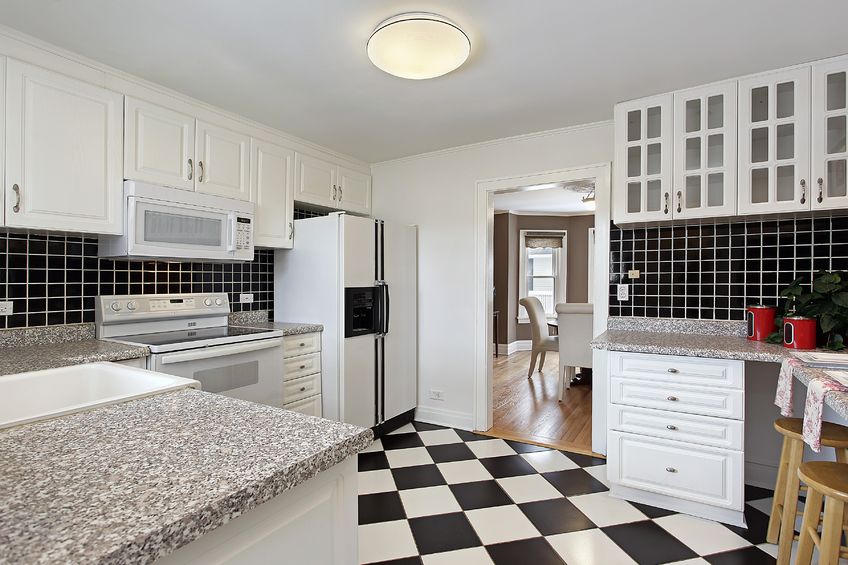
A very intelligently put together kitchen with black wall tiles and white cabinets mirroring the checkered tile pattern on the floor. Note the contrast of the white grout and black tiles
The Herringbone Tile Pattern
The Basics: A medium skill level at least, is required to install this more complicated looking floor tile pattern. Named for its resemblance to the skeleton of the Herring, a bony fish, this timeless option uses rectangular tiles. The tiles are lined up at a 45 degree angle so that they are all parallel. This is repeated in reverse on the other side of the tiles, like a mirror image. This creates an imaginary line with tiles coming out on either side like a “V.” It is aptly named because it really does look similar to the rib bones branching off of the spine of a fish! The herringbone tile pattern has been heavily used in Europe for hundreds of years because of its elegant yet intricate look.
Tile Home Guide Secret Tips:
– Using the herringbone pattern is a trick designers use to enhance the size of a small room. The eye tends to look at the wide “V’s” which are created by the opposing tiles instead of the narrowness of the room.
-While this tile pattern works wonders in small or narrow rooms, it sometimes tends to look too busy when used in large ones.
-Use this one in hallways (especially narrow ones) to not only increase how wide it is perceived, but to draw the eye of the viewer into the next room as well. The “V’s,” do this wonderfully as they are very similar to the points of arrows, pointing you in the right direction.
-Another option are herringbone mosaic tiles, which make this pattern easy for the DIY homeowner. Each tile is made up of small pieces, usually of stone that are attached to a mesh backing that form the herringbone pattern on each individual tile. And when these individual tiles are all lined up they form the herringbone pattern but much more intricate looking than with larger tiles. Using mosaic tiles of this pattern allows you to use it on the wall, which is great news are looking for a unique kitchen backsplash.
-The herringbone tile pattern is perfectly suited for floors of kitchens with islands. This is because it helps to keep the island from taking away from the size of the space and making it look cluttered. The herringbone pattern helps to maintain the appearance of the width of the room while allowing you to utilize it as well.
-If you are a DIY homeowner, unless you have considerable tile laying skills, or are using mosaic tiles, this is one project you should probably leave to a pro.
-Don’t forget outdoors, the herringbone tile pattern really shines on walkways and patios too.
The Basket Weave Tile Pattern
The Basics: This wall and floor pattern looks like the stitching of a woven basket, and like herringbone, it also uses rectangular tiles. It’s fairly easy to install. These tiles are lined up in groups of either 2 or 3 vertically or horizontally to form a square. If the first square is made up of vertically positioned tiles, the adjacent squares will be made up of horizontally placed ones. This alternating between the horizontal and vertical creates the impression of the tiles being woven over and under each other just like a basket.
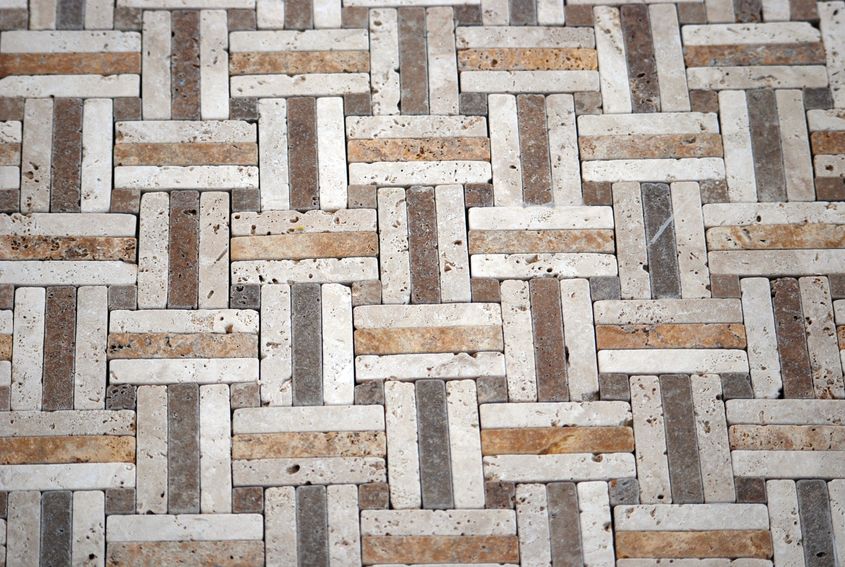
A perfect example of how adjacent perpendicular and vertical tiles can create the illusion of being woven over and under eachother in this example of the basket weave tile pattern
Tile Home Guide Secret Tips:
-Use basket weave if you want to create a classic and classy early 1900’s feel. It works especially well when used with stones like marble.
-This is one of the tile layout patterns which can be used on the wall as well, and works perfectly to create a unique and stylish backsplash.
-Basketweave mosaic tiles are individual tiles which are made up of small vertical and horizontal pieces that form basket weave design. When placed next to each other these small basket weave designs perfectly line up to for a myriad of interweaving lines that looks amazing.
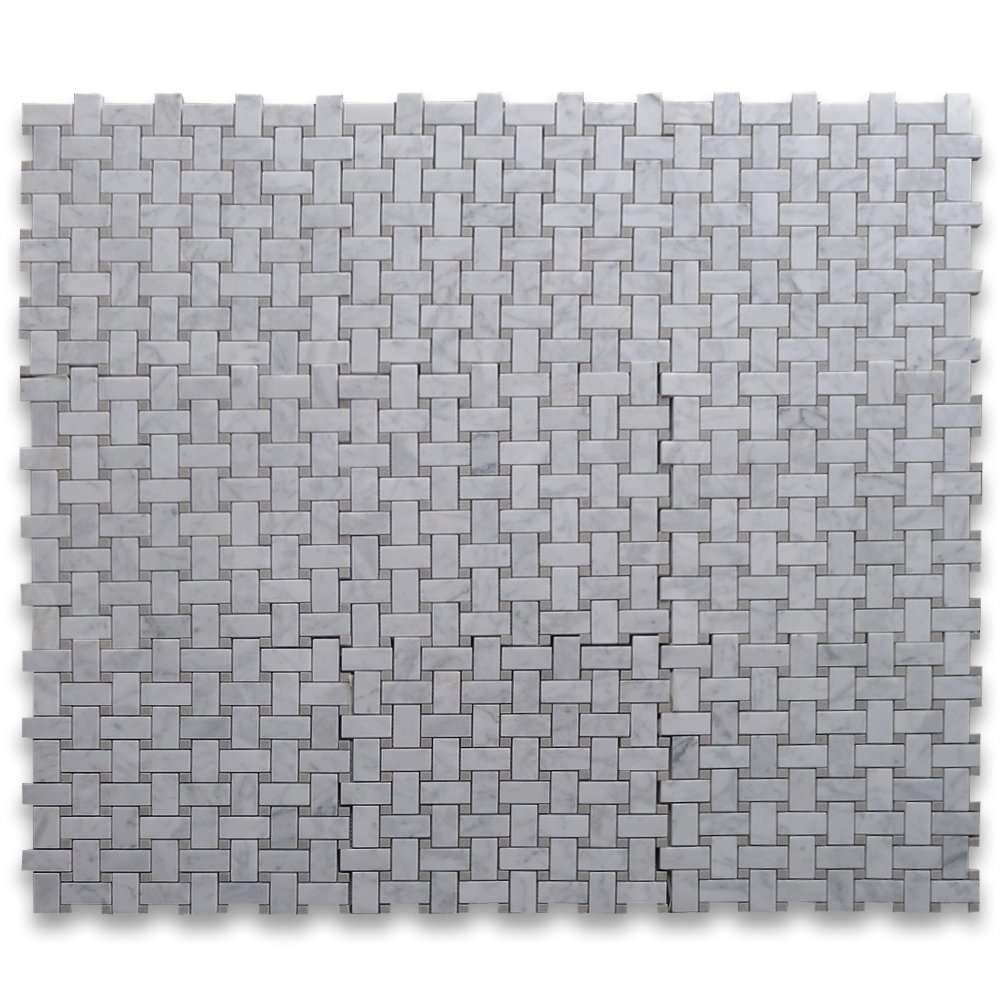
You can see how these 9 marble mosaic tiles in the basketweave pattern line up to complete the pattern
-Like Herringbone, this pattern is one which works best in smaller spaces and should avoid using in large rooms as it may look too busy. Basket weave one of most often used foyer and bathroom tile patterns.
The Windmill Tile Pattern
The Basics: The name of this pattern comes from its resemblance to the blades of a windmill. 4 rectangular tiles are used to form the shape of a large square with 1 smaller square tile in the middle to make this pattern look like a turning windmill. The look of square tile can make this seem like you are looking at a grid of dots and while it is normally thought of as one of floor tile patterns it can be used on the wall and some people even like it so much they use it in the shower!
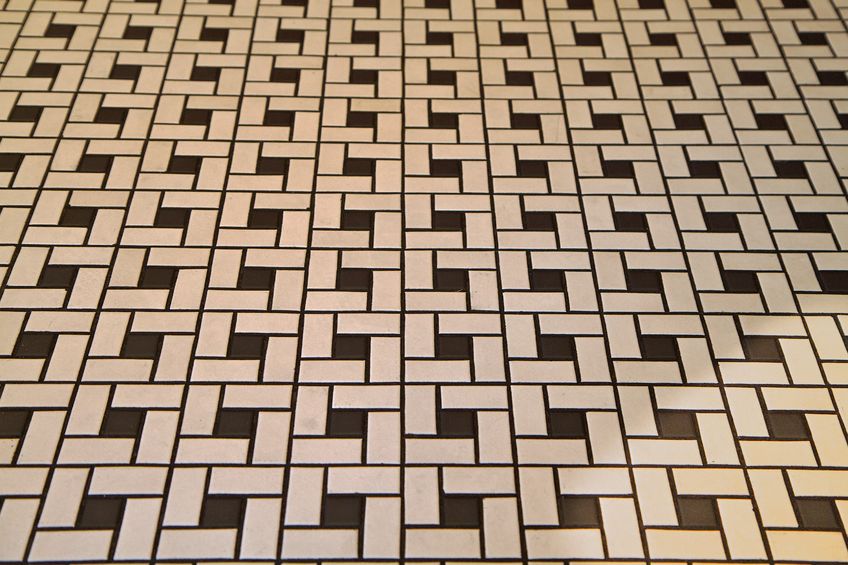
This black and white windmill pattern shows how 2 colors looks great, but more than that can easily cause it to look too busy
Tile Home Guide Secret Tips:
-The windmill tile pattern can be used to created an interesting backsplash but also works great when used as a border pattern.
-There are many other materials you can use besides ceramic or porcelain. So don’t be afraid to think outside the box.
-Using a different color for the small tile in the center can really make the pattern pop. Two contrasting colors or one neutral one used with a a more vibrant one is sure to get some attention.
-For this pattern to look proportionate it is imperative to use the correct ratios. For the rectangular tile this ratio 2:1. So if the length of the rectangular tile is 8 inches the width should be 4 inches. The size of the square tile is also determined from this and should be the same size as the width of the rectangle, so in this case it would be a 4 inch by 4 inch square.
-An easier way to do deal with the ratios is by using mosaic tile, although the pattern will be on a smaller scale. It’s up to your preference.
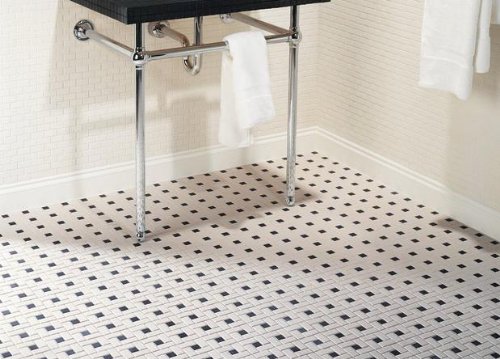
The cobalt blue in the center on the white background of these windmill mosaic tiles shows up strikingly well
The Versailles Tile Pattern
The Basics: Unlike other tile patterns Versailles goes by 3 names as it is also referred to as the French or the modular pattern. The Versailles uses a combination of 4 different tile sizes: 8″x8”, 8″x16”, 16″x16”, and 16″x24”. Elegant and graceful, yet also timeless, this pattern can be used indoors or out to create a feel of randomness but without the chaos. It is pleasing to the eye because while it appears random, but in reality the tiles fit together in a large repeating puzzle-like pattern which is perfectly balanced. While Versailles works amazingly well indoors it is most often seen outdoors and almost always uses stone tiles like travertine. It almost is exclusively a floor pattern and is very difficult to install as you could imagine.
Tile Home Guide Secret Tips:
-This is another pattern which is probably better left to the pros for installation. But if you do decide to take on a project using this pattern make sure you start with a dry layout (as you always should) and begin tiling from the center of the space and work your way out. You therefore must lay down the first few tiles very carefully because they will determine the placement of all of the other tiles.
-The best way to purchase tiles for this pattern is in kits or bundles which have the correct ratio of tile to cover: 8, 16, or 44 square feet. And while you may end up with a few extra tiles, you’re always better off with some to spare in case of breakage or damage anyway.
The Pinwheel Tile Pattern
The Basics: This floor tile pattern is sometimes also called the hopscotch. Many people confuse it with the windmill pattern which looks similar but uses larger tiles to surround a smaller one . The pinwheel does the exact opposite. Four small squares placed around each of the four corners of a single large square tile. This creates a shape similar to that of a spinning pinwheel. While it is not overly complicated, it still needs to be planned out carefully so you should have some tile laying skills if you are going to get this one right.
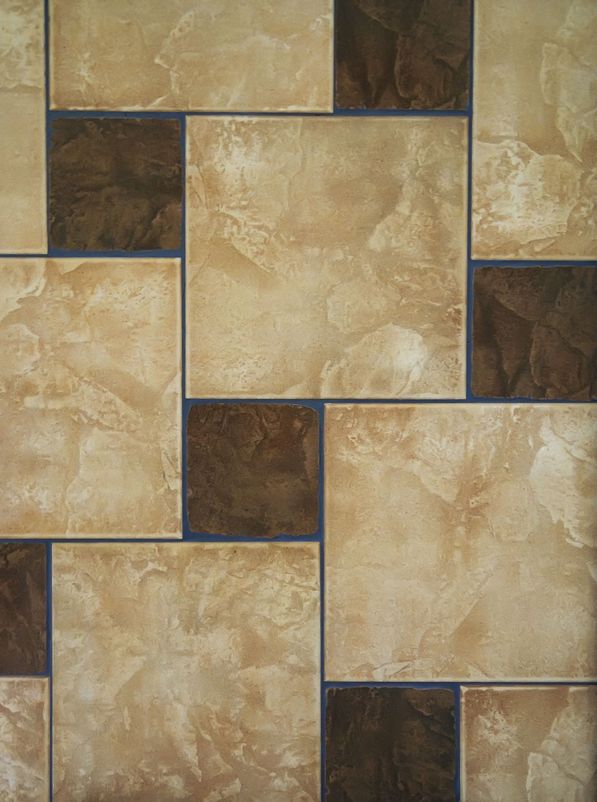
In this close up you can see how the small squares convey movement and look like a spinning pinwheel
Tile Home Guide Secret Tips:
-While pinwheel can really be done with any 2 size square tiles, the best ration is 2:1 which means the larger tile should be twice the size of the smaller ones.
-Use 2 colors to make this pattern pop, but using more you run the risk of creating something too busy for your space.
These patterns all work exceptionally well at their specific applications when used correctly. Let your creativity, style, and imagination run wild while keeping these tips in mind and you should be well on your way to transforming your space and getting the most from the pattern you choose!
3 Steps to Success BEFORE You Choose a Tile Pattern
Taking these three steps before committing to any one pattern, will guarantee you avoid the most common pitfalls involved when installing a tile pattern in or outside of your home.
Decide What You Want To Achieve
This sounds silly but you would be surprised to find out just how many people choose a pattern without really knowing what they want to accomplish. Figuring this out first will save you money, time, and an enormous amount of frustration. You don’t want to finish your new project only to decide it’s not what you really wanted. This will mean having to tear it out and start again which equals lost time and money. Even worse, some homeowners decide to settle with the results and will have to look at them daily in frustration and regret for years to come. Each pattern has a different function and different look, so take your time, look at examples and ask yourself what you really want? A retro look? A luxurious one? Simple yet chic? Decide on the desired result first and you won’t have to rely on getting lucky to end up with it.
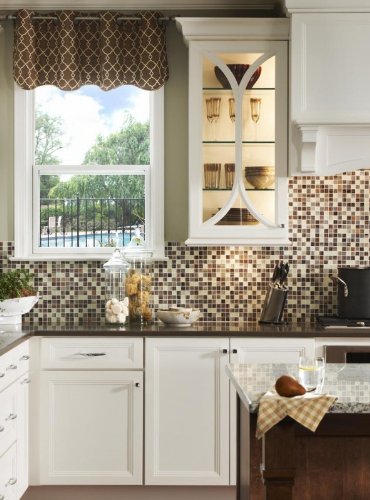
This kitchen backsplash using the straight lay with glass and metal tiles accents the countertops shelves and cabinets
Take a Realistic Look at the Space You Are Working With
If you want to get the most out of any tile pattern you need to really look at the room or space you are dealing with. Is it big or small? Wide or narrow? What is the existing style of the room or area you are working with? What style or feel are you going for? These are all things you need to take into consideration. Each tile laying pattern has its own specific abilities to work in certain types of spaces. This also means that they don’t work in other ones. The herringbone pattern for example really looks fantastic in smaller areas but in larger ones is too busy. After looking at your space in a realistic way, you may have to change your expectations on what you want to achieve. You may not. It all depends on the unique area you are going to be working with.
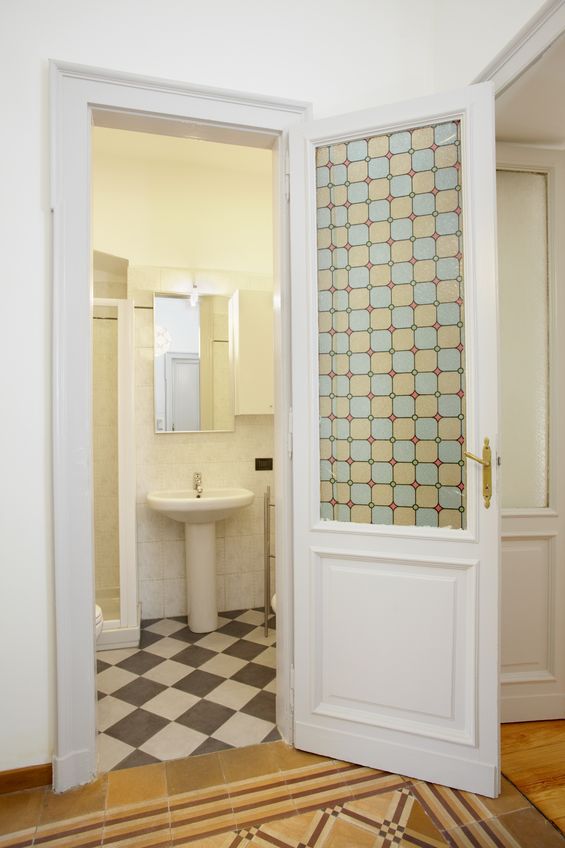
A charming choice for this small bathroom the checkerboard pattern not only goes very well, but set at a diagonal creates a sense of space
Pick a Material That Can Work With Your Pattern of Choice
Just like all patterns don’t work with all spaces, some materials don’t work well with all patterns. Others fit like a glove. Each material is different. Some are so heavy they can be used only as floor tile, while others are so delicate they can only be used as wall tile, and a quite a few can even be used as both. While most tiles can be used indoors not all materials can work as outdoor tiles. If you are planning an outdoor project you will have to choose a material that can handle the elements. Many patterns need to use tiles that are specific shapes or dimensions, which sometimes can’t be done with certain materials. The running bond tile pattern for example needs rectangular shaped tiles. And last of all, some materials just look better than others with certain patterns, like how the Versailles tile pattern goes phenomenally well with travertine. So once you have a pattern in mind choose a material that can work with it and make it look good.
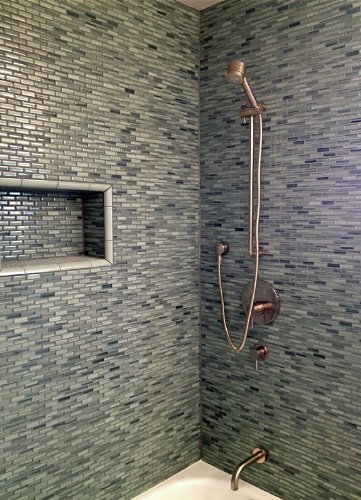
Using the running bond these aqua blue and grey hand-painted glass subway mosaic tiles make this shower look simply amazing
Taking a few hours to have some fun and look at your options will help you complete these three easy steps in no time. You will end up saving your time, money, and anxiety. And the best part is you will receive the end effect of the pattern, the space, and the material all working together to provide you with the ultimate result: a beautiful space.
An Extra 10 Tile Pattern Secrets:
1) Larger tiles tend to make a small room appear bigger! If you have a small room using a tile pattern with very large tiles will give the illusion that the room is bigger than it really is.
2) Another secret for making a small room appear bigger is using very small tiles, seeing so many small tiles tricks the brain into thinking the room is actually larger than it happens to be.
3) Using a focal point such as a motif or mosaic tile medallion at the far end of a narrow room will take the eye off of how limited your space is as well as make the room interesting.
4) Using the straight lay tile pattern in a narrow room will make the room look even more narrow because our eyes will naturally pick up on the grout lines as parallel to the walls and see it as a smaller space. Using the diagonal pattern is a better idea.
5) While it can be tempting, don’t combine too many different patterns, it will look to busy. Keep it simple by choosing only 1 or 2.
6) Keep it simple when choosing tile materials, using 3 different materials or less will look much better and will add to affect of your pattern as opposed to taking away from it.
7)You can incorporate a tile border to not only define your pattern but also lead the eye into adjacent rooms.
8) Using different tile patterns to define different areas of a room is a great way to incorporate the beauty of multiple patterns but also show the functionality of a space as well.
9) Choosing a color for your pattern that echoes another color in the room, or the color from a focal point (such as a view of the ocean or mountains) is a great way to get the most out of the pattern, material, and the tiles you choose.
10) Accent tiles are a perfect tool to use to add emphasis to the style you are trying to portray as well as to the pattern you choose.

